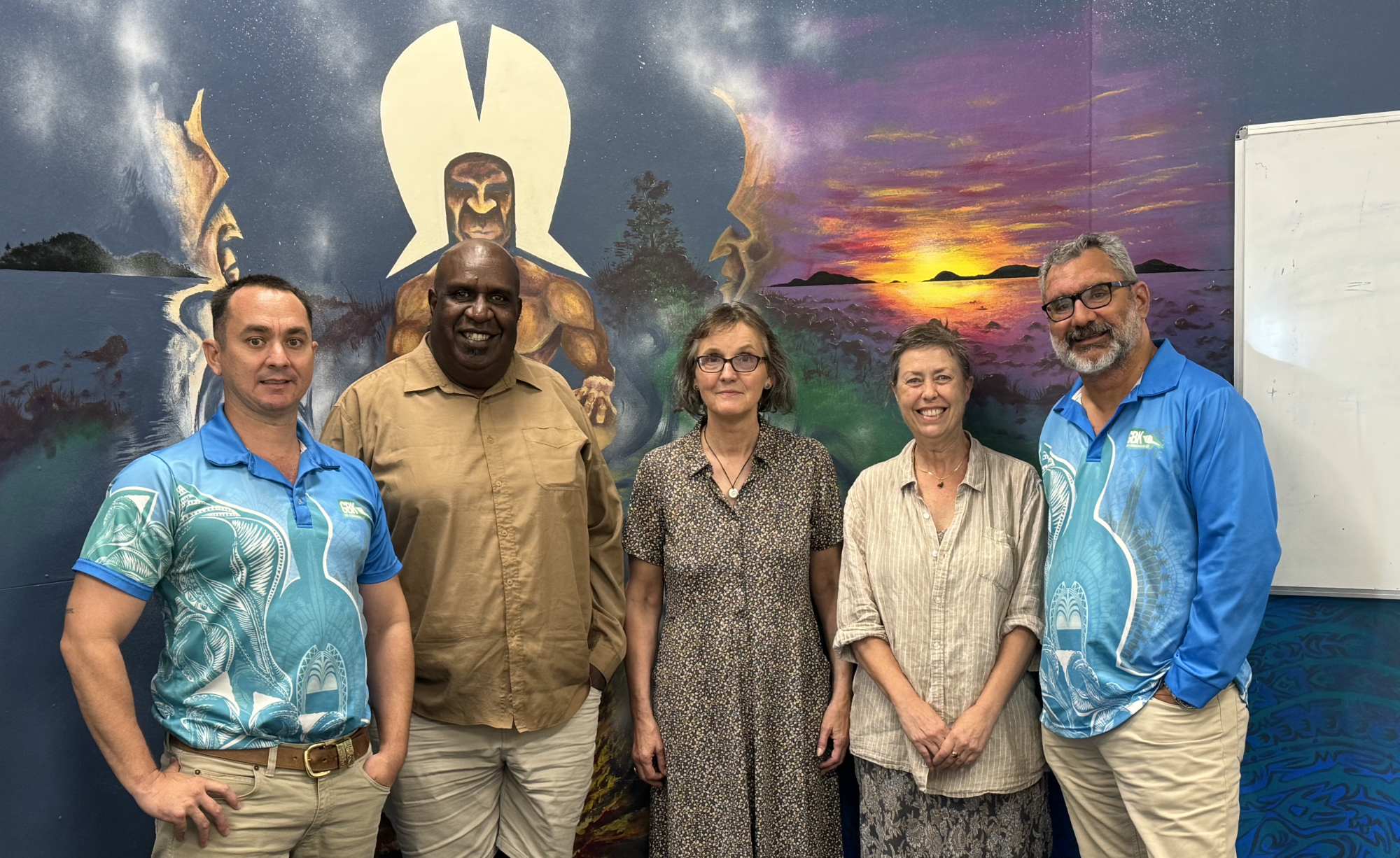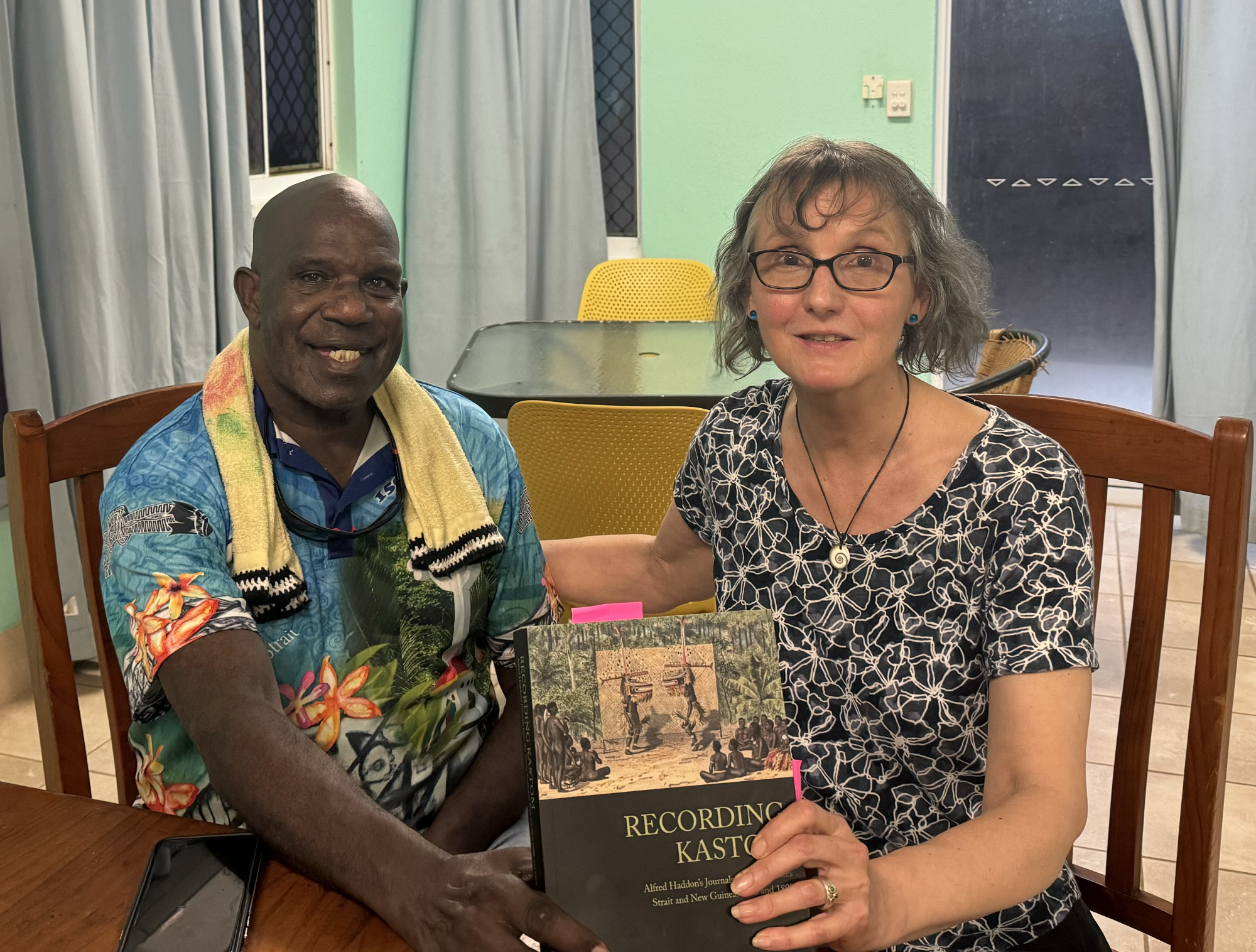21 Oct 2025 | Anita Herle
Mobilising anthropology’s archive: Returning Alfred Haddon’s journals to the Torres Strait
The publication and reception of Recording Kastom: Alfred Haddon’s Journals from the Torres Strait and New Guinea, 1888 and 1898 [1] reveals the far-reaching and continuing value of ethnographic archives and museum collections for scholarly research and community empowerment.[2] In 2024, with support of the Cambridge LMU Strategic Partnership, we re-visited the Torres Strait to discuss our collaborative project to return Haddon’s journals, published in full and contextualised within our joint publication. Knowledge about the past is selectively and productively mobilised by Islanders to illuminate family and community histories and address pressing concerns related to cultural and environmental sustainability and political self-determination.
 Page from Haddon’s journal describing the Wai-tutu-kap (Dance of the saw-fish), Thursday Island, November 1888. Haddon 1888-89: 69. Photo: Museum of Archaeology and Anthropology, Cambridge.
Page from Haddon’s journal describing the Wai-tutu-kap (Dance of the saw-fish), Thursday Island, November 1888. Haddon 1888-89: 69. Photo: Museum of Archaeology and Anthropology, Cambridge.
Alfred Haddon, a key figure in the early history of British anthropology, is widely acknowledged for his extensive work in the Torres Strait region, the development of fieldwork methodologies and his impact on the professionalisation of anthropology. A Cambridge-trained natural scientist, his anthropological interests developed during his first field trip to the region in 1888 to study marine biology. Prompted by the Islanders who worked with him and shared his concerns about the detrimental impact of traders, missionaries and colonial officials on Islander kastom,[3] Haddon returned as the leader of the 1898 Cambridge Anthropological Expedition to the Torres Strait.[4] Within a paradigm of salvage ethnography, the seven expedition members developed a multidisciplinary project encompassing anthropology in its broadest sense. With the active involvement of named Islanders, the Expedition’s work generated an enormous body of information and materials (objects, photographs, drawings, kinships charts, sound recordings and film), much of which is now cared for at the University of Cambridge Museum of Archaeology and Anthropology (MAA). Crucially, Haddon named his Islander assistants and ‘friends’ in his journals, and attributed knowledge to particular individuals in his publications. Information from the Expedition’s Reports[5] has been pivotal in establishing Islanders’ territorial claims on land and sea in decisive law cases, including the Murray Island Land Case ‘Mabo’ (1992)[6] and the Torres Strait Sea Claim Case (2013).
Haddon’s journals provide an intimate and beautifully illustrated account of his observations and experiences. While Haddon’s research focused on recording information about past kastom, his journals include lively vignettes of everyday life and reveal how and from whom Haddon obtained information and collections, as well as the broader social and political context of his research. One can see how the Expedition’s expectations and goals were assisted, challenged and modified through close interactions with Islander hosts and collaborators.
The publication of Haddon’s journals was part of a long process of engagement between MAA and Torres Strait Islanders, which has included collaborative exhibitions,[7] the return of photographs to their islands of origin,[8] and a steady stream of Islander visitors to Cambridge to connect with the collections.[9] Plans to publish and make accessible the hand-written journals were first discussed during a field trip to the region in 2016 with co-author and co-editor Jude Philp (Senior Curator Macleay Collections, University of Sydney). We met with Islander representatives, including direct descendants of the people who worked with Haddon, from the four main Island communities where his research was based – Goemulgal on Mabuiag, Meraim on Mer, Kulkalgal from Iama, and Aboriginal representatives for the Kaurareg Nation on Muralag. Overall people were interested but cautious about how their ancestors and communities would be represented. During the following year, transcriptions were produced and relevant sections distributed to families and community representatives. Following intermittent communications and long phone conversations we received unanimous approval to go ahead. We returned to the Torres Strait in 2018 to report on progress and discuss publication plans. As in 2016, we arranged small group meetings and larger community presentations. We also gave a formal presentation to the board of the Torres Strait Regional Authority (TSRA), who offered their support.
 Meeting at the GBK office with (l-r) Bernard Keenam (general manager), Elija Wasaga (Chair of the Kaurareg Nation), Anita Herle, Jude Philp, Ned David (Chair of the GBK), Thursday Island, 11 September 2024. Photo: private.
Meeting at the GBK office with (l-r) Bernard Keenam (general manager), Elija Wasaga (Chair of the Kaurareg Nation), Anita Herle, Jude Philp, Ned David (Chair of the GBK), Thursday Island, 11 September 2024. Photo: private.
The key concern was accessibility to Islanders. Given patchy internet access and relatively few personal computers, it was deemed essential to have a hard copy publication that could readily be distributed throughout the region. Negotiations with Sydney University Press and guidance from Islanders informed the design and materiality of the book, resulting in a full-colour high-quality publication that ‘felt good to hold’, tangibly and metaphorically. Islanders were particularly keen to see photographs of their ancestors and to locate items related to family and community histories in museum collections. Building on Haddon’s care in naming people, subsequent collections research and Islander input, we worked to identify as many people in the photographs as possible and indexed the names of every person noted in the text and captions. Throughout the book we linked Haddon’s narrative with his extensive collections in Cambridge and other museums, and provided details as to how they could be accessed. We also linked passages in the text to the Expedition’s sound recordings, preserved on wax cylinders now in the British Library. Extensive footnotes were used to identify the many people threaded through Haddon’s narrative and to provide contextual information. The final publication includes a substantial introductory essay, all of the original 120 journal drawings, 200 associated field photographs, Indigenous drawings and images of some of the objects collected. We were honoured that Islander colleagues Ned David (Chair of the Gur a Baradharaw Kod Sea and Land Council (GBK) and Chair of the TSI Regional Education Council) and Leah Lui-Chivizhe (historian at the University of Sydney) generously provided their perspectives in the Foreword and Epilogue.
Thanks to support from the Torres Strait Regional Authority, the Australian Institute of Aboriginal and Torres Strait Islander Studies, the Monash University Indigenous Studies Centre and the Haddon family we were able to distribute free copies of the book to our collaborators as well as schools, libraries and community groups across the Torres Strait, and to Indigenous centres on mainland Australia. Unfortunately, the process of return was hampered due to Covid restrictions and initial feedback from the Torres Strait was limited to phone conversations, occasional emails and Facebook posts. In 2025, with support from the Australian Maritime Museum, Jude Philp returned copies to key leaders and institutions in Port Moresby, where Haddon and the team also spent considerable time.
 Anita Herle with Cygnet Repu, Senior Elder and TSRA Portfolio leader for Culture, Art and Heritage, with Recording Kastom: Alfred Haddon’s Journals from the Torres Strait and New Guinea, 1888 and 1898, Mabuiag Island, 17 September 2024. Photo: Jude Philp.
Anita Herle with Cygnet Repu, Senior Elder and TSRA Portfolio leader for Culture, Art and Heritage, with Recording Kastom: Alfred Haddon’s Journals from the Torres Strait and New Guinea, 1888 and 1898, Mabuiag Island, 17 September 2024. Photo: Jude Philp.
When we finally had the opportunity to re-visit the Torres Strait in 2024, we were warmly received. First port of call was a meeting at the GBK offices to review past projects and explore the possibilities of future collaborative work, including the development of a local archive. As the principal Native Title Service Provider for the region, the GBK has particular interest in promoting self-determination and maintaining a strong and dynamic Ailan (Island) Kastom. We were also invited to give a community presentation about the journals on Mabuiag Island as part of the National Aboriginal and Islanders Day Observance Committee (NAIDOC) celebrations. Our motivations and practices, including processes of consultation, were examined during a two-hour recorded interview, conducted as part of Elder John Ngailu Whop’s doctoral research at the Bachelor Institute of Indigenous Tertiary Education. Researching the role of traditional arts in Mabuiag Island culture, he emphasised the importance of the publication of Haddon’s journals, describing it as ‘like a bible’.
The enthusiasm of Islanders to meet with us and their interest in Recording Kastom intersected with a general reticence to discuss details related to personal and family histories. Many of the stories prompted by the publication of Haddon’s journals are private and only discussed with specific family members, elders and community groups. This privacy is perhaps the best indication of the book’s significance, not focussed on ‘proof’ of worth through public statements and writings, but rather useful and reflective as Islanders continue to disentangle their histories from colonial records. More broadly, the Torres Strait archives and collections continue to be a crucial resource for cultural descendants, a source of inspiration for Islander artists, and are used extensively and critically in affirmations of Ailan Kastom and in native title claims.
Acknowledgements
I thank Jude Philp and the many Islanders who provided advice and hospitality for the project to publish Haddon’s journals. I am grateful to Philipp Schorch for his ongoing encouragement and to Luisa Marten for her careful editing. I thank the Cambridge LMU Strategic Partnership and the Bavarian State Government for their support to return to the Torres Strait in 2024.
_____________
[1] Herle, Anita, and Jude Philp, eds. 2020. Recording Kastom: Alfred Haddon's Journals from the Torres Strait and New Guinea, 1888 and 1898. Sydney: Sydney University Press.
[2] Herle, Anita, and Jude Philp. 2022. “Decolonizing Anthropology’s Archives: Alfred Haddon’s Journals from the Torres Strait and new Guinea, 1888 and 1898.” Journal of Museum Ethnography 35: 24-45.
[3] Kastom refers to “the body of customs, traditions, observances and beliefs of some or all of the Torres Strait Islanders living in the Torres Strait area (…)” (Torres Strait Islander Commission Act, 2019). Kastom is a dynamic concept which refers to contemporary knowledge and practices that derive authenticity from the perceived derivation from the pre-colonial past.
[4] Herle, Anita, and Sandra Rouse, eds. 1998. Cambridge and the Torres Strait: Centenary Essays on the 1898 Anthropological Expedition. Cambridge: Cambridge University Press.
[5] Haddon, Alfred, ed. 1901-1935. The Reports of the 1898 Cambridge Anthropological Expedition to the Torres Strait. Volumes 1-6. Cambridge: Cambridge University Press.
[6] Commonly referred to as the ‘Mabo’ decision after the leading plaintiff Eddie Koiki Mabo, this landmark case marked the first time the Australian courts recognised Indigenous rights to land prior to colonisation and effectively overturned 200 years of terra nullius.
[7] Herle, Anita, and Jude Philp. 1998. Torres Strait Islanders: An Exhibition Marking the Centenary of the 1898 Cambridge Anthropological Exhibition. Museum exhibition. Cambridge: Museum of Archaeology and Anthropology.
Philp, Jude. 2001. Past Time: Torres Strait Islander Material from the Haddon Collection, 1888-1905. Museum exhibition. Canberra: National Museum of Australia.
[8] Herle, Anita, Jude Philp, and Jocelyne Dudding. 2015. Reactivating Visual Histories: Haddon’s Photographs from Mabuyag 1888, 1898. In Goemulgaw Lagal: Cultural and Natural Histories of the Island of Mabuyag, Torres Strait, edited by Ian McNiven and Garrick Hitchcock. Memoirs of the Queensland Museum 8 (1): 253-288. Brisbane: Queensland Museum.
[9] Herle, Anita. 2003. “Objects, Agency and Museums: Continuing Dialogues Between the Torres Strait and Cambridge.” In Museums and Source Communities, edited by Laura Lynn Peers and Alison Key Brown. London: Routledge, 194-207.
Read more about Anita's project Torres Strait: Co-activating environmental and cultural relations in museum collections.

